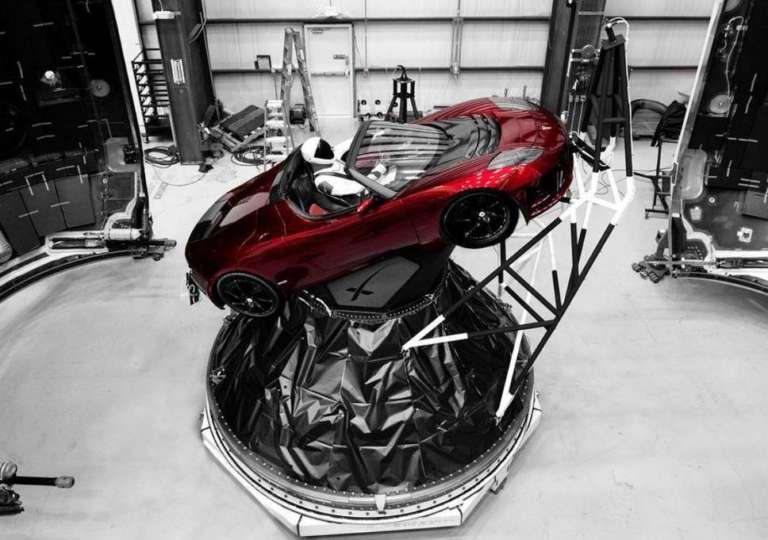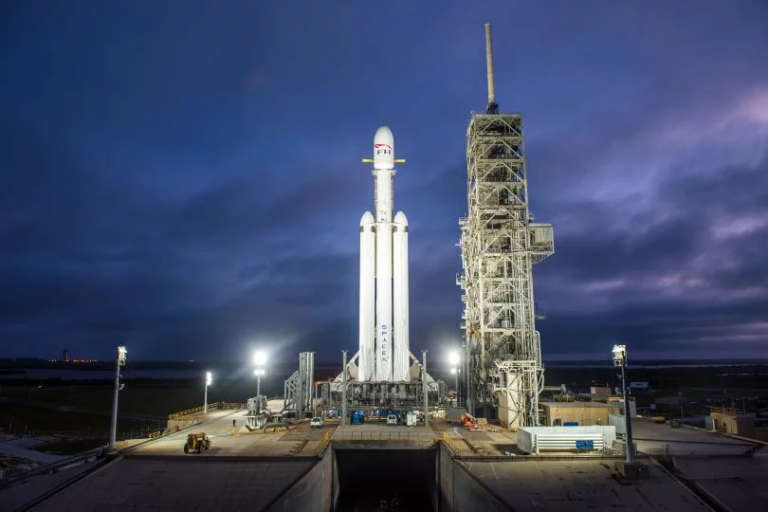Jason Davis • Feb 05, 2018
Let's talk about Elon Musk launching his Tesla into space
At first, I wasn't sure I was going to write about Elon Musk launching his Tesla Roadster into space on this week's Falcon Heavy test flight. Given the mixed reactions I've seen online, dissecting the Tesla didn't seem worth it, especially since the real star of the show is a giant new rocket that could revolutionize spaceflight.
Then, I found myself describing the test flight to my friend Porter. Porter is an artist and school art teacher who loves space, though he's not necessarily plugged in to all the latest space happenings. That's where I come in, frequently giving him quick rundowns of cool space news.
When I told him about the Roadster, he responded with a mix of incredulity and awe. I opened my phone to pictures of the car in the Falcon Heavy's cavernous payload fairing, and tried to answer his questions: Yes, it's real. Because you have to add mass to the vehicle and this is cooler than concrete. It's going into orbit around the Sun somewhere between Earth and Mars.
Porter absorbed all this, sat back, and thought for a minute.
"I don't think I like it," he finally said.
"Why not?"
"I don't know... it just seems like such a waste."

Porter eventually clarified it seemed like a wasted opportunity to do something more beautiful, more inspiring—more artistic. Maybe he had something in mind more like Peter Beck's Humanity Star, the "disco ball" RocketLab recently launched into space. But art is subjective, and not everyone is thrilled with the Humanity Star, either.
On the one hand, it seems like a harmless publicity stunt—not that SpaceX or Tesla really need publicity help. I confess it appeals to my inner adolescent, and comes from the mind of a guy who recently made headlines for selling $500 flamethrowers. There may also be some nose-thumbing going on here: As I mentioned in my preview article, the Falcon Heavy could help SpaceX capture the geostationary and beyond-Earth human exploration launch markets, completing the company's upheaval of one the world's most entrenched industries. Tesla, meanwhile, if successful with the Model 3, could deal a serious blow to traditional U.S. automakers. What better way to rub those achievements in than by orchestrating such a grandiose gesture?
On the other hand, rather than throwing away a perfectly good supercar, Musk could have donated it to charity for auction. The carbon footprint and factory labor used to build the car will be destroyed for no reason. SpaceX could have also asked if anyone wanted to gamble a satellite for this high-risk mission, though integrating satellites to a rocket isn't trivial and SpaceX probably wants to avoid the logistics.
Moreover, the Tesla stunt just rubs some people the wrong way. Here's what I mean:
I already dislike Elon Musk so much, but between the shooting a Tesla into space and making branded flamethrowers lately I just can’t
— Jamie Molaro (@spacejammie) February 1, 2018
I think we as a species have a new definition of "Money To Burn". Send your really expensive car to orbit mars to prove a point... https://t.co/gyGt7YgMxA
— Erik S. Bailey (@esba1ley) December 3, 2017
I mean, I appreciate the objective is glorious failure. But the charm of destroying expensive shit for giggles falls a bit flat when the actual economic future is a dumpster fire. https://t.co/YqFf62gJm7
— Mika McKinnon (@mikamckinnon) December 2, 2017
As a symbol, a red sports car really doesn't do it for me. Masculine mid-life crisis? https://t.co/9APk4jsnsH #mars
— Alice Gorman (@drspacejunk) December 2, 2017
2018 will be a big letdown from Red Dragon to red Tesla. In lieu of a serious program for Mars next year, we've got a stunt. Maybe.
— Parabolicarc.com (@spacecom) December 2, 2017
My biggest Tesla interest—or concern, if you prefer—surrounds the lack of information about the car's orbit, and the chances of it hitting Mars.
NASA goes to great lengths sterilizing spacecraft designed to land on Mars, in order to make sure there's no chance of Earthly microbes contaminating the surface. Such a contamination could harm existing life and muddle scientific efforts to search for said life. This concern might only last until humans arrive, but in the meantime, planetary protection is such a huge concern, it actually hinders NASA's ability to search for life! There are endless debates on whether current rovers like Curiosity, or future rovers like Mars 2020, should be allowed to investigate spots where briny water may (or may not) ooze onto the surface.
I asked a Mars mission expert at NASA's Jet Propulsion Laboratory whether pieces of the Tesla, should it hit Mars, would survive atmospheric entry and make it to the surface. Probably, he said, reminding me that chunks of Curiosity's cruise stage made new artificial craters on the surface.
As far as I know, the only hard evidence about the Tesla's trajectory comes from a tweet by Elon Musk and a quote from Musk in a story by Phil Plait. On Twitter, Musk said "Destination is Mars orbit. Will be in deep space for a billion years or so if it doesn't blow up on ascent," and he later clarified to Plait this meant a "precessing Earth-Mars elliptical orbit around the sun."
I reached out to half a dozen aerospace engineers for interpretations of Musk's quotes. The general consensus was that the Tesla was probably headed to an elliptical orbit with a aphelion (maximum Sun distance) around 1.5 AU and a perihelion (minimum Sun distance) around 1 AU. In other words, the car will be in an egg-shaped orbit around the sun intersecting Mars orbit at the far point and Earth orbit at the close point.
Max Fagin, an engineer at Made In Space, kindly made me a hypothetical animation laying out what all this might look like, based on what we know about the Falcon Heavy's capabilities and its probable launch date:
Most of the engineers I contacted were quick to remind me that it's very difficult to hit Mars even if you're trying. Earth and Mars aren't optimally aligned right now (they won't be until around the time Insight launches to Mars in May), and intentionally smacking into Mars would almost certainly require a trajectory correction en route (meaning the Tesla would have to fire its thrusters—and it doesn't have any).
So, it's probably safe to say the Tesla will miss Mars on the first pass. But what about Musk's claim the Tesla will cruise through space for a billion years?
That's harder to parse. As the Tesla tumbles through the inner solar system, it will be subject to occasional gravitational tugs from Earth and Mars (and possibly Jupiter, one engineer said). In theory, one of those tugs could eventually put the Tesla on a collision course with Earth or Mars. None of the engineers could give me the odds of this happening because there aren't enough concrete orbital parameters available for the Tesla. Most agreed the chances were probably small. How small, no one could say.

What does the law say about all this? Not much. Launching something from U.S. soil requires a permit from the FAA. FAA regulations do not explicitly address planetary protection, though the agency requires launch providers follow international laws. The Outer Space Treaty mandates the protection of worlds like Mars by all signatory nations, which includes the U.S., but it's questionable whether the FAA has jurisdiction over the Tesla after it separates from the Falcon Heavy.
In the short term, none of this really matters. Whether or not the car blows up over the Atlantic, hits Mars a hundred years from now, or tumbles through the solar system until the Sun balloons into a red giant is largely inconsequential. What is worth considering is the Tesla as a case study for future commercial space ventures. We've reached the point where individuals like Elon Musk and Peter Beck—in this case, two wealthy, white men—can make unilateral statements for humanity in space.
The Trump administration has directed NASA to establish a permanent presence on the Moon to enable deep space commercialization, while Musk himself hopes to soon send 100-passenger spaceships to Mars. Part of the appeal of human space exploration is the potential to, for lack of a better phrase, create a better version of ourselves in space. But who is "ourselves," and what does that really mean? The amount of Earthly social baggage the first hundred people carry to Mars will greatly influence humanity's future in space—and if you don't believe me, read Kim Stanley Robinson's Red Mars.
Ultimately, that's why it's worth talking about the Tesla.
Support our core enterprises
Your support powers our mission to explore worlds, find life, and defend Earth. You make all the difference when you make a gift. Give today!
Donate

 Explore Worlds
Explore Worlds Find Life
Find Life Defend Earth
Defend Earth

